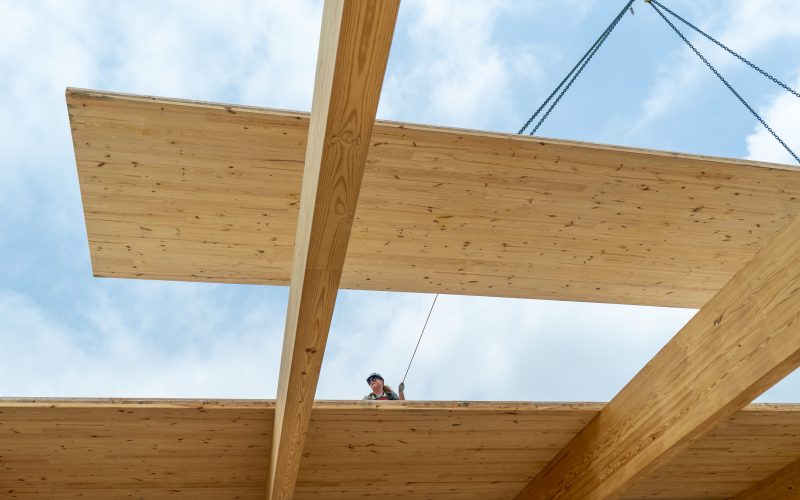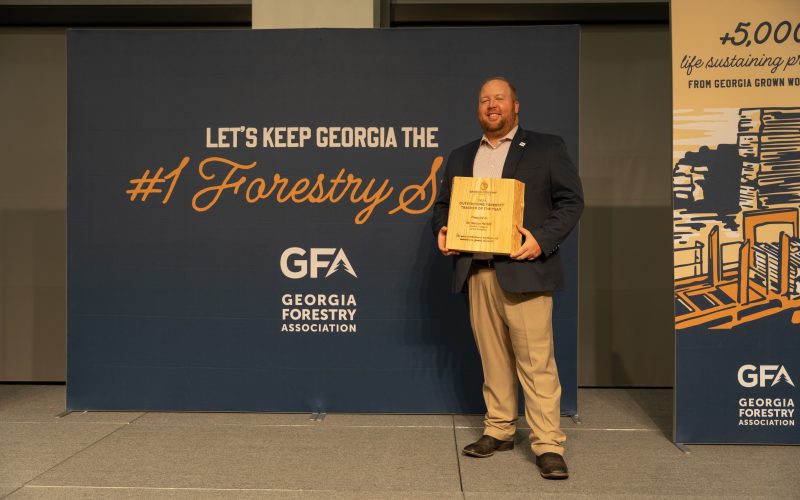New Timber Tax Reform Legislation Heads to November General Election Ballot
Retired from a 37-year corporate management career, Mac Peden knows what it takes for an investment to be profitable and he understands the burden that property tax can have on the long-term viability of owning forestland. Thanks to the recent passage of House Resolution 51, a constitutional amendment, and House Bill 85, its enabling legislation, much needed uniformity and equity will be delivered to landowners across the state in terms of property taxation.
Peden currently resides in Atlanta with his wife Susanne. His sons, Michael and Benjamin also live in the metro region with their families. Most weekends, Peden travels to his second home in Hancock County, a cabin nestled in a 2,500-acre tree farm that has been a part of his family for several generations.
Since inheriting a small portion of the land from his father in 1993, Peden has taken an active role in managing and acquiring land as an investment. In addition to timber harvests, he has hunting leases spread out across the property to offset the property’s annual tax bill. Thankfully, hunting leases in the region are competitive enough to be profitable for landowners like Peden. Additionally, to lower the overall tax burden on the land, he has enrolled the entirety in a covenant through the state’s Conservation Use Value Assessment (CUVA) program.

“In order for forest land to remain profitable, the tax system must take into account the long-term investment nature of owning and actively managing timberland,” Peden said. “If it weren’t for the hunt leases and CUVA, I’m not sure that we would be able to continue acquiring and managing forestland like we do currently”
Passed as a constitutional amendment in 1991, CUVA allows non-industrial private landowners with 10-2,000 acres of agricultural land, timber land or environmentally sensitive land to enter a 10-year conservation covenant. Land enrolled in the program is taxed on 40 percent of the current use value.
17 years later, the Forest Land Protection Act (FLPA) was passed as an expansion of CUVA. The legislation, which has no acreage cap, allows both non-industrial property owners and corporations to put their property into a covenant for at least 15 years and to receive a lower tax burden for as long as the land is kept in forestry.
Today, land enrolled in CUVA and FLPA make up about nearly 80 percent of the 18.4 million acres of Forestland on local property tax rolls in Georgia. According to Steve McWilliams, former GFA president and veteran of several campaigns to improve and simplify taxation of privately owned timberland, increasingly more favorable property tax policy for forestland is one reason that today Georgia has more timberland than it did 50 years ago.
“Unlike most other crops and other business types, forest land may not produce significant income for several years until timber is mature enough to be cut – even longer if markets for timber are weak,” he said. “But the property tax bill comes every year regardless.”
McWilliams continued: “Changes in forestland tax policy in the past 30 years have gone a long way toward creating fairness for landowners and encouraging them to keep their land in trees.”
And that’s a good thing. Georgia’s 22 million acres of commercially available timberland are largely owned by private, non-industrial landowners like Peden. They use their own resources to manage the land for clean air, clean water, wildlife habitat and several ecosystem services that benefit every Georgian. Not to mention, they employ more than 140,000 Georgians and contribute over $35 billion to the economy.
Both CUVA and FLPA have been monumental for the 450,000 forest landowners like Peden across the state; however, even with those two programs, Georgia landowners are at a competitive disadvantage when the average property tax rate is compared to surrounding states.
According to a study from the Warnell School of Forestry and Natural Resources and commissioned by the Georgia Forestry Foundation’s Center for Forest Competitiveness, Georgia’s forestland property tax is among the highest in the South at an average of $6.65 per acre. Average property tax throughout the south isn’t close. Of eight surrounding southern states, the lowest average rate is Arkansas at $1.25 per acre and the second highest next to Georgia is $3.07 per acre in Virginia. Alabama, Louisiana, Mississippi, North Carolina and South Carolina fall between the two.

In addition, conservation programs such as CUVA and FLPA don’t work for every forest landowner. Land enrolled in CUVA must be owned by a single owner or a family partnership – corporate ownerships or non-family partnerships do not qualify. Corporate and non-family owners do qualify for FLPA, but if the land is under 200 consecutive acres, they cannot qualify.
The result is 4.7 million acres of “rural woodland” in Georgia that are not under one of the conservation programs. Those landowners pay up to $15.42 per acre on average.
Inequity from Improper Valuations
The 159 counties in Georgia each have their own boards of tax assessors. Despite uniform guidance from the state on how timberland values are appraised, the guidance is interpreted differently by each county which has resulted in a very wide range of timberland values for landowners. Many smaller rural counties are also at a disadvantage because they do not have the budget to employ trained staff to perform the complicated process in valuing timberland. In fact, according to The Department of Audits only one out of four counties have properly extracted the value of standing timber from the land as required by the Constitution of the State of Georgia.
Inaccurate valuation has also impacted counties with land enrolled in FLPA. Each year, the state is required to provide local assistance grants to counties, school boards and cities to offset a portion of the property tax revenue lost from FLPA. The current law provides a specific formula for calculating the assistance grant payments to the counties by requiring the use of 2008 as the base year for fair market value of forest land. This provision essentially would have worked well if all 159 counties had revalued land in 2007 or 2008. But that did not happen and the formula ended up locking-in assistance grants for nearly all of Georgia’s counties at rates that were either below or above what they should have been. There were even some counties that we overpaid more than $1 million a year – money that should have gone to other counties.
Voters to Approve Legislation in November
In order to address the issues with uniformity for land not enrolled in a conservation program as well as land enrolled in CUVA and FLPA, the Georgia Forestry Association championed the passage of HR 51 and HB 85, which was approved by both chambers of the Georgia General Assembly and signed by the Governor in early May. Because the legislation is a constitutional amendment, voters will have the opportunity to approve the legislation on the general election ballot in November.
- Established a new class of land titled “Qualified Timberland Property”
Provides landowners with the opportunity for their land to be assessed at fair market value as determined by the Department of Revenue (rather than county tax assessors). To qualify, the land must be a minimum of 50 acres and the land must be managed for producing commercial timber. Qualified landowners will not be required to sign a covenant, but they are required to file an annual return to maintain their status. - Reduced the FLPA covenant length and property size requirement
Currently, land enrolled in FLPA must be 200 continuous acres and landowners must sign a 15-year covenant. Under the new legislation, an aggregate of 200 acres across the state may qualify (if parcels exceed 100 acres in any given county) and the covenant length is reduced to 10 years. - Adjusted the FLPA formula used in calculating local assistance grants to counties
The current formula establishes fair market value (FMV) on 2008 base-year, which has resulted in over and under payments to counties. The new legislation will update the FMV base to the current year. To reduce the impact on counties that lose funding, a 5-year phase-in will be put in place to help smooth the transition.
If approved by Georgia voters, the legislation will be the most significant update to the ad valorem tax law since the passage of the Forest Land Protection Act in 2008. House Ways & Means Chairman Rep. Jay Powell (R-Camilla) was the primary sponsor of the bill.
“Our private forest owners are consistently supporting our state’s economy and environment, using their own resources,” Rep. Powell said. “This legislation helps to address several issues in the conservation use assessment of timberland to create a fair system for forest landowners while maintaining funding for counties throughout the state.”
Richard Royal, 30-year veteran of the Georgia General Assembly, former chair of the House Ways & Means Committee and a policy consultant to the Association, was the author and primary sponsor of FLPA in 2008. Royal agrees that the bill will be critical for Georgia landowners.
“This tax legislation is imperative to keeping Georgia the number one forestry state in the nation,” Royal said. “The Department of Revenue, with trained professionals, will now establish fair market values for the new classification of qualified timberland, which will result in uniform and accurate land valuations. In addition, the correct extraction of timber values from the land values will provide much needed property tax relief to the timberland owners not enrolled in CUVA or FLPA.”
Perhaps the most important aspect of this legislation is that it keeps forestland as a viable, and profitable, investment for all forest landowners while maintaining the funding for rural communities. According to analysis from the University of Georgia, some counties, like Hancock County, are set to gain a significantly larger amount from the change in the FLPA formula.
“Hancock County and the City of Sparta are my ancestral home, and the community here is important to me,” Peden said. “I am glad this bill takes a step in the right direction to give private forest owners some tax relief while maintaining the funding for our county schools and public services.”








